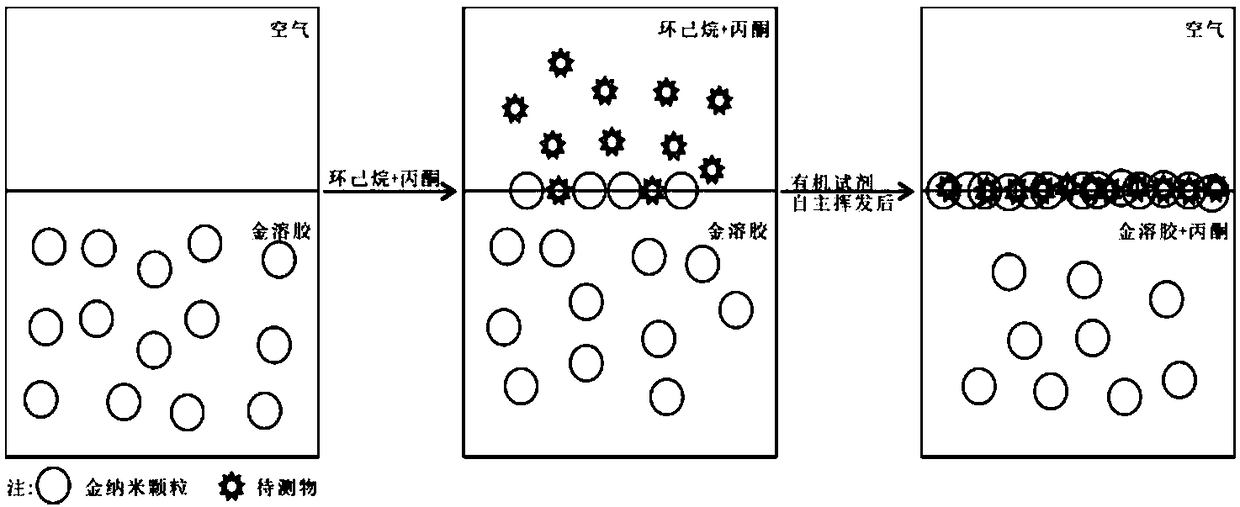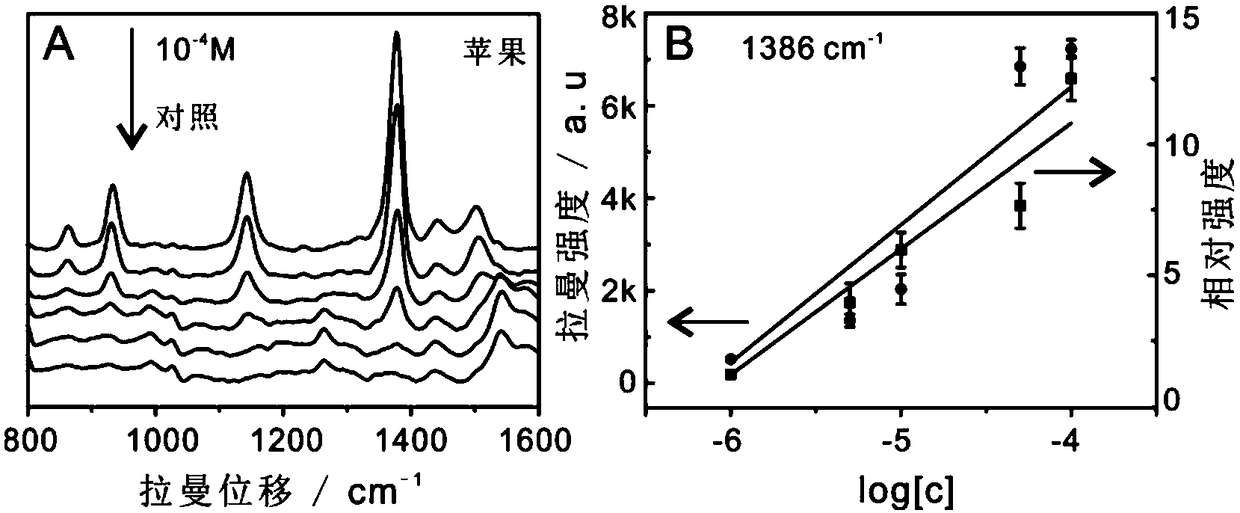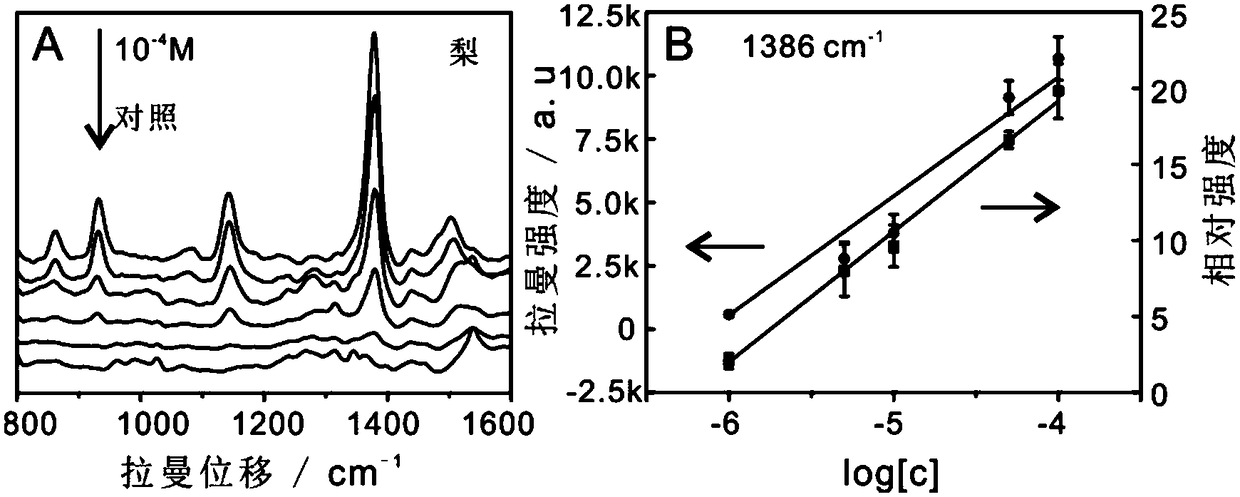Liquid-liquid interface detection method for surface-enhanced Raman spectroscopy
A surface-enhanced Raman and detection method technology, applied in the field of sensitive analysis and detection, can solve the problems of non-transplantation, time-consuming, susceptible to interference, etc., to reduce the influence of background signals, improve throughput and efficiency, and ensure stable control Effect
- Summary
- Abstract
- Description
- Claims
- Application Information
AI Technical Summary
Problems solved by technology
Method used
Image
Examples
Embodiment 1
[0034] Gold particles were synthesized by citrate reduction method and hydroxylamine hydrochloride reduction method, and dispersed in the water phase after centrifugal concentration to form gold nano-sol;
[0035] After the apples are cleaned, remove the peel with a radius of 0.45 cm, drop 50 μL of thiram double standard solution, and let it dry naturally; extracted extract;
[0036] Take 50 μL of the extract and add it to 100 μL of gold nanosol. Under the induction of acetone, the gold nanoparticles self-assemble on the liquid-liquid interface into a nanoparticle array film with metallic luster (such as figure 1 shown), use it as a Raman scattering active substrate to directly detect Raman with a Raman spectrometer, the parameters of the Raman spectrometer: microscope objective lens × 20, excitation wavelength 785nm, detection wavelength 800-1600cm -1 , laser power 2mW, integration time 8s, accumulation times 1 time.
[0037] Such as figure 2 Shown in A is that the double...
Embodiment 2
[0040] Gold particles were synthesized by citrate reduction method and hydroxylamine hydrochloride reduction method, and dispersed in the water phase after centrifugal concentration to form gold nano-sol;
[0041] After cleaning the pears, remove the pericarp with a radius of 0.45 cm, add 50 μL of thiram double standard solution dropwise, and let it dry naturally; put it into a mixed solution of 450 μL of acetone and cyclohexane (10:1 by volume) Extraction; then take 50 μL of the extract and add it to 100 μL of gold nanosol. Under the induction of acetone, the gold nanoparticles self-assemble on the liquid-liquid interface to form a nanoparticle array film with metallic luster, which is used as a Raman scattering active substrate. Use a Raman spectrometer to directly perform Raman detection. The parameters of the Raman spectrometer: microscope objective lens × 20, excitation wavelength 785nm, detection wavelength 800-1600cm -1 , laser power 2mW, integration time 8s, accumulati...
Embodiment 3
[0045] The total molar number of the two analytes, thiram and tiramidine, is 1.25×10 -10 mol, the molar ratios of the two are 5:0, 4:1, 3:2, 2:3, 1:4, 0:5, respectively.
[0046] The detection system is 100 μL of gold nanoparticle sol and 50 μL of cyclohexane and acetone (v:v=1:1) containing the analyte, both of which are dissolved in the organic phase; -1 、1010cm -1 The characteristic peaks are respectively used as the linear indicators of thiram and Tibiline two analytes. The parameters of the Raman spectrometer are: microscope objective lens × 20, excitation wavelength 785nm, detection wavelength 400-1600cm -1 , laser power 2mW, integration time 8s, accumulation times 1 time.
[0047] Figure 4 A is the Raman spectrum of the two pesticides with different molar ratios. It shows that the Raman intensity increases linearly with the increase of the molar number of Albiline; at the same time, the Raman intensity decreases gradually with the decrease of the molar number of th...
PUM
 Login to View More
Login to View More Abstract
Description
Claims
Application Information
 Login to View More
Login to View More - R&D
- Intellectual Property
- Life Sciences
- Materials
- Tech Scout
- Unparalleled Data Quality
- Higher Quality Content
- 60% Fewer Hallucinations
Browse by: Latest US Patents, China's latest patents, Technical Efficacy Thesaurus, Application Domain, Technology Topic, Popular Technical Reports.
© 2025 PatSnap. All rights reserved.Legal|Privacy policy|Modern Slavery Act Transparency Statement|Sitemap|About US| Contact US: help@patsnap.com



